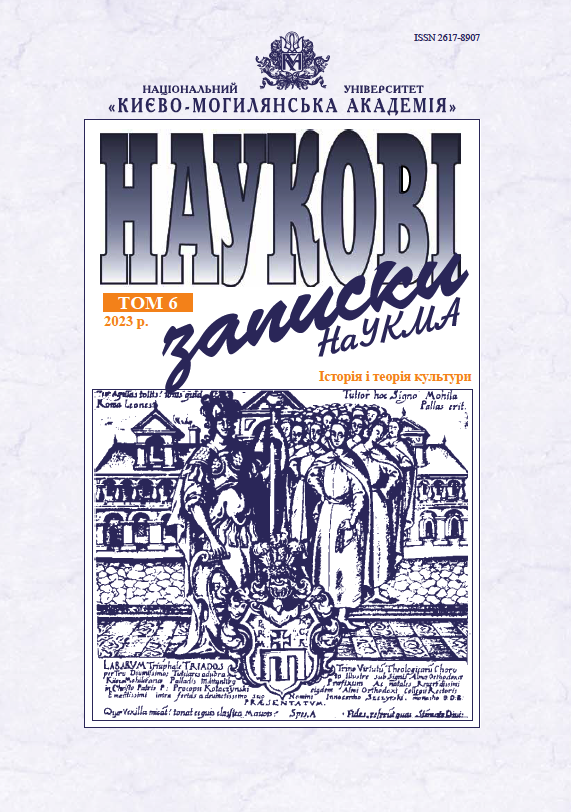Танатологічний ракурс соціокультурного розвитку людства
DOI:
https://doi.org/10.18523/2617-8907.2023.6.15-23Ключові слова:
Death studies, танатологія культурно-історична, історична культурологія, соціокультурні трансформації, цивілізаційні процеси, уявлення про смерть, потойбіччя, есхатологічний символізм, традиційна картина світуАнотація
У статті автор звертає увагу на принциповий зв’язок уявлень про смерть і потойбіччя з цивілізаційними векторами розвитку людства. Запропоновано декілька соціокультурних спостережень щодо певних стародавніх соціумів у контексті культурно-історичної танатології від пізньої первісності до «аксіальної» зрілості включно: небо як первинна локація позатілесних сутностей (себто духів, душ та їхніх аналогів); концепт голови та маски як їхнє тимчасове вмістилище; просторові уявлення про потойбіччя, втілені в поховальних спорудах; категорія межі в традиційній міфологічній свідомості, а також характерні злами свідомості епічної. Окремо розглянуто танатичні уявлення в суспільствах «аксіального» типу і як це допомагає виявити настання такої фази за певного соціокультурного етапу чергової держави.
Посилання
- Abrutyn, Seth. 2014. “Religious autonomy and religious entrepreneurship : An evolutionary-institutionalist’s take on the axial age.” Comparative Sociology 13 (2): 105–34.
- Armit, Ian. 2012. Headhunting and the Body in Iron Age Europe. Cambridge University Press.
- Assmann, Jan. 2011. Death and salvation in ancient Egypt. Translator David Lorton. 2nd ed. Cornell University Press.
- Barrowclough, David. 2014. Time to Slay Vampire Burials? The Archaeological and Historical Evidence for Vampires in Europe. Cambridge: Red Dagger Press.
- Baumard, Nicolas, Alexandre Hyafil, and Pascal Boyer. 2015. “What changed during the axial age : Cognitive styles or reward systems?” Communicative & Integrative Biology 8 (5), e1046657. https://doi.org/10.1080/19420889.2015.1046657.
- Black, Antony. 2008. “The “Axial Period” : What Was It and What Does It Signify?” The Review of Politics 70 (1): 23–39. http://www.jstor.org/stable/20452955.
- Bolshakov, Andrei. 1999. “Razvitie predstavleniy o ‘zagrobnykh mirakh’ v drevnem Yegipte.” Meroe 5 : 55–71 [in Russian].
- Bolshakov, Andrei. 2001. Chelovek i ego Dvoynik. Izobrazitelnost i mirovozzrenie v Yegipte Starogo tsarstva. St. Petersburg: Aletheia [in Russian].
- Boy, John D., and John Torpey. 2013. “Inventing the axial age: the origins and uses of a historical concept.” Theory and Society 42 (3): 241–59. https://doi.org/10.1007/s11186-013-9193-0.
- Burke, Peter. 2008. What is cultural history? 2nd ed. Polity. Chmykhov, Mykola. 1994. Davnia kultura. Kyiv: Lybid [in Ukrainian].
- Cook, Constance A. 2009. “Ancestor worship during the Eastern Zhou.” In Early Chinese Religion, Part One: Shang through Han (1250 BC-220 AD) (2 vols.), 235–79. Brill.
- Eisenstadt, Shmuel N. 1982. “The axial age : The emergence of transcendental visions and the rise of clerics.” European Journal of Sociology / Archives Européennes de Sociologie 23 (2): 294–314.
- Ellis[-Davidson], Hilda. 1968. The road to Hel: a study of the conception of the dead in Old Norse literature. Cambridge University Press.
- Flier, Andrei. 2011. “Cultural History as a Knowledge Domain.” Journal of Cultural Research 2 (4). https://cyberleninka.ru/article/n/istoricheskaya-kulturologiya-kak-oblast-znaniya/viewer [in Russian].
- Geller, Pamela. 2012. “Parting (with) the dead: Body partibility as evidence of commoner ancestor veneration.” Ancient Mesoamerica 23 (1): 115–30.
- Golan, Ariel. 1993. Myth and symbol. Moscow: Russlit [in Russian]. Gurevich, Aaron. 1992. “Filipp Aries: smert kak problema istoricheskoy antropologii.” In Aries F. Chelovek pered litsom smerti, 5–32. Moscow: Progress-Akademiia [in Russian].
- Hartner, Willie. 1969. Die Goldhörner von Gallehus : Die Inschriften – Die ikonographischen und literarischen Beziehungen – Das Entstehungsdatum. Wiesbaden: Franz Steiner Verlag.
- Jaspers, Karl. 2021. “World History”: 1st part of his The Origin and Goal of History (Foreword by Christopher Thornhill), 2–92. London / N.-Y.
- Kelley, David H., and Eugene F. Milone. 2011. Exploring ancient skies: A survey of ancient and cultural astronomy. New York: Springer.
- Klochko, Liudmyla. 2020. “Hiunivska plastyna: obrazy ta siuzhet.” In Illinska Varvara Andriivna – vydatna doslidnytsia Skifii, 40–43. Kyiv [in Ukrainian].
- Korol, Denys. 2005. “Motiv ‘vsadnika’ i ‘vstrechayushchey bogini’ na pogrebalnykh kamnyakh Skandinavii i Severnogo Prichernomorya.” [“The ‘Horseman and the Welcoming Goddess’ motive from the Burial stones of Scandinavia and Black Sea Region”]. Strukturno-semioticheskie issledovaniya v arkheologii 2: 331–44. https://ekmair.ukma.edu.ua/items/b47319df-e338-4780-8fc4-9c53caf1591b [in Russian].
- Korol, Denys. 2015. Vstup do istorychnoi tanatolohii. Kyiv: NaUKMA [in Ukrainian].
- Kosarev, Mihail. 2008. Osnovy yazycheskogo miroponimaniya: po sibirskim arkheologo-etnograficheskim materialam. Moscow: Ladoga-100 [in Russian].
- Kuijt, Ian, Mehmet Özdoğan, and Mike Parker Pearson. 2009. “Neolithic skull removal : Enemies, ancestors, and memory [with Comments].” Paléorient 35 (1): 117–27.
- Mednikova, Mariia. 2002. “Scalping in Eurasia.” Anthropology & Archeology of Eurasia 40 (4): 57–67.
- Mees, Bernard. 2009. Celtic curses. Woodbridge: Boydell Press. Miton, Helena, Nicolas Claidière, and Hugo Mercier. 2015. “Universal cognitive mechanisms explain the cultural success of bloodletting.” Evolution and Human Behavior 36 (4): 303–12.
- Mosionzhnik, Leonid. 2006. Chelovek pered litsom kultury. Chisinau: Higher Anthropological School [in Russian].
- Munson, Jessica, Viviana Amati, Mark Collard, and Martha J. Macri. 2014. “Classic Maya bloodletting and the cultural evolution of religious rituals: quantifying patterns of variation in hieroglyphic texts.” PloS one 9 (9): e107982. https://doi.org/10.1371/journal.pone.0107982/
- O’Connor, Ralph James. 2008. “Storytelling and the Otherworld in Togail Bruidne Da Derga.” In Approaches to Mythology and Religion in Celtic Studies, edited by A. Bergholm and K. Ritari, 54–67. Cambridge Scholars Publishing.
- Pavlenko, Yurii. 2004. Istoriya mirovoy tsivilizatsii. Filosofskiy analiz. 2nd ed. Kyiv: Feniks [in Russian].
- Pirazzoli-t’Serstevens, Michèle. 2009. “Death and the Dead: Practices and Images in the Qin and Han.” In Early Chinese Religion, Part One: Shang through Han (1250 BC-220 AD) (2 vols.), 1005–82. Brill.
- Proulx, Donald A. 2001. “Ritual uses of trophy heads in ancient Nasca society.” In Ritual sacrifice in ancient Peru, edited by Elizabeth Benson and Anita Cook, 119–36. Austin: University of Texas Press.
- Ritner, Robert Kriech. 1993. The mechanics of ancient Egyptian magical practice (series: Studies in ancient Oriental civilization, 54). Chicago: University of Chicago.
- Root, Dolores. 1983. “Information exchange and the spatial configurations of egalitarian societies.” In Archaeological hammers and theories, 193–219. Academic Press.
- Sayers, William. 1993. “Charting conceptual space : Dumézil’s tripartition and the fatal hostel in early Irish literature.” Mankind Quarterly 34 (1): 27–64.
- Shenkao, Mukhamed. 2003. Smert kak sotsiokulturnyy fenomen. Kyiv: Nika-Centre [in Russian].
- Tihomirova, Ekaterina. 2012. “‘Maski mertvykh’ – ideya maski v posmertii.” Sovremennye problemy nauki i obrazovaniya 6: 682–9 [in Russian].
- Tarasenko, Mykola. 2004. “Modeli prostorovoho svitospryiniattia u davnoiehypetskii kosmohrafii.” Skhidnyi svit 3: 61–75 [in Ukrainian].
- Tarasenko, Mykola. 2009. Drevneegipetskaya mifologiya v izobrazitelnoy traditsii Knigi Mertvykh: vinetki glav 16, 17 i 42 v Novom tsarstve – Tretem perekhodnom periode. Kyiv: Interpress LTD [in Russian].
- Toporova, Tatiana. 2001. “Opyt analiza teksta : ‘Razrushenie Doma Da Derga’ i ‘Proritsanie velvy’.” Arbor Mundi 8: 87–95 [in Russian].
- Vertiienko, Hanna. 2015. Ikonohrafiia skifskoi eskhatolohii. Kyiv: Oleh Filiuk [in Ukrainian].
- Watkins, Trevor. 2008. “Supra-regional networks in the Neolithic of Southwest Asia.” Journal of World Prehistory 21: 139–71.
##submission.downloads##
Опубліковано
Як цитувати
Номер
Розділ
Ліцензія
Авторське право (c) 2023 Denys Korol

Ця робота ліцензується відповідно до Creative Commons Attribution 4.0 International License.
Автори, які публікуються у цьому журналі, погоджуються з такими умовами:
а) Автори зберігають за собою авторські права на твір на умовах ліцензії CC BY 4.0 Creative Commons Attribution International License, котра дозволяє іншим особам вільно поширювати (копіювати і розповсюджувати матеріал у будь-якому вигляді чи форматі) та змінювати (міксувати, трансформувати, і брати матеріал за основу для будь-яких цілей, навіть комерційних) опублікований твір на умовах зазначення авторства.
б) Журнал дозволяє автору (авторам) зберігати авторські права без обмежень.
в) Автори мають право укладати самостійні додаткові угоди щодо поширення твору (наприклад, розміщувати роботу в електронному репозитарії), за умови збереження посилання на його першу публікацію. (Див. Політика Самоархівування)
г) Політика журналу дозволяє розміщення авторами в мережі Інтернет (наприклад, у репозитаріях) тексту статті, як до подання його до редакції, так і під час його редакційного опрацювання, оскільки це сприяє виникненню продуктивної наукової дискусії та позитивно позначається на оперативності та динаміці цитування опублікованої роботи (див. The Effect of Open Access).



